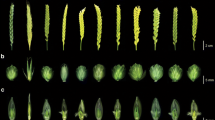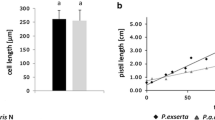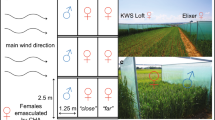Abstract
Key message
Elite wheat pollinators are critical for successful hybrid breeding. We identified Rht-B1 and Ppd-D1 loci affecting multiple pollinator traits and therefore represent major targets for improving hybrid seed production.
Abstract
Hybrid breeding has a great potential to significantly boost wheat yields. Ideal male pollinators would be taller in stature, contain many spikelets well-spaced along the spike and exhibit high extrusion of large anthers. Most importantly, flowering time would match with that of the female parent. Available genetic resources for developing an elite wheat pollinator are limited, and the genetic basis for many of these traits is largely unknown. Here, we report on the genetic analysis of pollinator traits using biparental mapping populations. We identified two anther extrusion QTLs of medium effect, one on chromosome 1BL and the other on 4BS coinciding with the semi-dwarfing Rht-B1 locus. The effect of Rht-B1 alleles on anther extrusion is genotype dependent, while tall plant Rht-B1a allele is consistently associated with large anthers. Multiple QTLs were identified at the Ppd-D1 locus for anther length, spikelet number and spike length, with the photoperiod-sensitive Ppd-D1b allele associated with favourable pollinator traits in the populations studied. We also demonstrated that homeoloci, Rht-D1 and Ppd-B1, influence anther length among other traits. These results suggest that combinations of Rht-B1 and Ppd-D1 alleles control multiple pollinator traits and should be major targets of hybrid wheat breeding programs.




Similar content being viewed by others
References
Abe M, Kobayashi Y, Yamamoto S, Daimon Y, Yamaguchi A, Ikeda Y, Ichinoki H, Notaguchi M, Goto K, Araki T (2005) FD, a bZIP protein mediating signals from the floral pathway integrator FT at the shoot apex. Science 309:1052–1056
Alghabari F, Lukac M, Jones HE, Gooding MJ (2014) Effect of Rht alleles on the tolerance of wheat grain set to high temperature and drought stress during booting and anthesis. J Agron Crop Sci 200:36–45
Beales J, Turner A, GriYths S, Snape JW, Laurie DA (2007) A Pseudo-Response Regulator is misexpressed in the photoperiod insensitive Ppd-D1a mutant of wheat (Triticum aestivum L.). Theor Appl Genet 115:721–733
Binghua L, Jingyang D (1986) A dominant gene for male-sterility in wheat. Plant Breed 97:204–209
Boden SA, Cavanagh C, Cullis BR, Ramm K, Greenwood J, Jean Finnegan E, Trevaskis B, Swain SM (2015) Ppd-1 is a key regulator of inflorescence architecture and paired spikelet development in wheat. Nat Plants 1:14016
Boeven PHG, Longin CFH, Leiser WL, Kollers S, Ebmeyer E, Wurschum T (2016) Genetic architecture of male floral traits required for hybrid wheat breeding. Theor Appl Genet 129:2343–2357
Boeven PHG, Würschum T, Rudloff J, Ebmeyer E, Longin CFH (2018) Hybrid seed set in wheat is a complex trait but can be improved indirectly by selection for male floral traits. Euphytica 214:110
Broman KW, Wu H, Sen S, Churchill GA (2003) R/qtl: QTL mapping in experimental crosses. Bioinformatics 19:889–890
Buerstmayr M, Buerstmayr H (2015) Comparative mapping of quantitative trait loci for Fusarium head blight resistance and anther retention in the winter wheat population Capo × Arina. Theor Appl Genet 128:1519–1530
Buerstmayr M, Buerstmayr H (2016) The semidwarfing alleles Rht-D1b and Rht-B1b show marked differences in their associations with anther-retention in wheat heads and with Fusarium head blight susceptibility. Phytopathology 106:1544–1552
Cheng Y, Dai X, Zhao Y (2006) Auxin biosynthesis by the YUCCA flavin monooxygenases controls the formation of floral organs and vascular tissues in Arabidopsis. Genes Dev 20:1790–1799
Daviere JM, Achard P (2016) A pivotal role of DELLAs in regulating multiple hormone signals. Mol Plant 9:10–20
Distelfeld A, Li C, Dubcovsky J (2009) Regulation of flowering in temperate cereals. Curr Opin Plant Biol 12:178–184
Elshire RJ, Glaubitz JC, Sun Q, Poland JA, Kawamoto K, Buckler ES, Mitchell SE (2011) A robust, simple genotyping-by-sequencing (GBS) approach for high diversity species. PLoS ONE 6:e19379
FAO (2015) Statistical pocketbook world food and agriculture 2015. Food and Agriculture Organization of the United Nations. http://www.fao.org/3/a-i4691e.pdf. Accessed 25 Nov 2018
Ghanem ME, Marrou H, Sinclair TR (2015) Physiological phenotyping of plants for crop improvement. Trends Plant Sci 20:139–144
Gilmour A, Gogel B, Cullis B, Thompson R (2009) ASReml user guide release 3.0. VSN International Ltd. https://www.vsni.co.uk/downloads/asreml/release3/UserGuide.pdf. Accessed 25 Nov 2018
Gils M, Kempe K, Boudichevskaia A, Jerchel R, Pescianschi D, Schmidt R, Kirchhoff M, Schachschneider R (2013) Quantitative assessment of wheat pollen shed by digital image analysis of trapped airborne pollen grains. Adv Crop Sci Technol 2:119
Griffiths S, Dunford RP, Coupland G, Laurie DA (2003) The evolution of CONSTANS-like gene families in barley, rice, and Arabidopsis. Plant Physiol 131:1855–1867
Guo Z, Song Y, Zhou R, Ren Z, Jia J (2010) Discovery, evaluation and distribution of haplotypes of the wheat Ppd-D1 gene. New Phytol 185:841–851
Halliwell J, Borrill P, Gordon A, Kowalczyk R, Pagano ML, Saccomanno B, Bentley AR, Uauy C, Cockram J (2016) Systematic investigation of FLOWERING LOCUS T-like Poaceae gene families identifies the short-day expressed flowering pathway gene, TaFT3 in wheat (Triticum aestivum L.). Plant Sci 7:857
He X, Lillemo M, Shi JR, Wu JR, Bjornstad A, Belova T, Dreisigacker S, Duveiller E, Singh P (2016a) QTL characterization of Fusarium head blight resistance in CIMMYT bread wheat line Soru#1. PLoS ONE 11:e0158052
He X, Singh PK, Dreisigacker S, Singh S, Lillemo M, Duveiller E (2016b) Dwarfing genes Rht-B1b and Rht-D1b are associated with both Type I FHB susceptibility and low anther extrusion in two bread wheat populations. PLoS ONE 11:e0162499
International Wheat Genome Sequencing C (2018) Shifting the limits in wheat research and breeding using a fully annotated reference genome. Science 361:eaar7191
Jimenez-Berni JA, Deery DM, Rozas-Larraondo P, Condon ATG, Rebetzke GJ, James RA, Bovill WD, Furbank RT, Sirault XRR (2018) High throughput determination of plant height, ground cover, and above-ground biomass in wheat with LiDAR. Front Plant Sci 9:237
Kneipp J (2017) Control of Fusarium head blight in northern NSW. https://grdc.com.au/research/reports/report?id=1916. Accessed 25 Nov 2018
Kosuge K, Watanabe N, Kuboyama T, Melnik VM, Yanchenko VI, Rosova MA, Goncharov NP (2008) Cytological and microsatellite mapping of mutant genes for spherical grain and compact spikes in durum wheat. Euphytica 159:289–296
Kowalski AM, Gooding M, Ferrante A, Slafer GA, Orford S, Gasperini D, Griffiths S (2016) Agronomic assessment of the wheat semi-dwarfing gene Rht8 in contrasting nitrogen treatments and water regimes. Field Crops Res 191:150–160
Langer SM, Longin CFH, Wurschum T (2014) Phenotypic evaluation of floral and flowering traits with relevance for hybrid breeding in wheat (Triticum aestivum L.). Plant Breed 133:433–441
Li C, Dubcovsky J (2008) Wheat FT protein regulates VRN1 transcription through interactions with FDL2. Plant J 55:543–554
Longin CFH, Muhleisen J, Maurer HP, Zhang HL, Gowda M, Reif JC (2012) Hybrid breeding in autogamous cereals. Theor Appl Genet 125:1087–1096
Longin CF, Gowda M, Muhleisen J, Ebmeyer E, Kazman E, Schachschneider R, Schacht J, Kirchhoff M, Zhao Y, Reif JC (2013) Hybrid wheat: quantitative genetic parameters and consequences for the design of breeding programs. Theor Appl Genet 126:2791–2801
Lu Q, Lillemo M, Skinnes H, He X, Shi J, Ji F, Dong Y, Bjornstad A (2013) Anther extrusion and plant height are associated with Type I resistance to Fusarium head blight in bread wheat line ‘Shanghai-3/Catbird’. Theor Appl Genet 126:317–334
Manske GGB, Ortiz-Monasterio JI, van Ginkel RM, Rajaram S, Vlek PLG (2002) Phosphorus use efficiency in tall, semi-dwarf and dwarf near-isogenic lines of spring wheat. Euphytica 125:113–119
Miedaner T, Schulthess AW, Gowda M, Reif JC, Longin CF (2017) High accuracy of predicting hybrid performance of Fusarium head blight resistance by mid-parent values in wheat. Theor Appl Genet 130:461–470
Milohnic J, Jost M (1970) Pollen production and anther extrusion of wheat (Triticum aestivum L. Em Thell.). Acta Agron Acad Sci Hung 19:17–23
Mulki MA, Bi X, von Korff M (2018) FLOWERING LOCUS T3 controls spikelet initiation but not floral development. Plant Physiol 178:1170–1186
Muqaddasi QH, Lohwasser U, Nagel M, Borner A, Pillen K, Roder MS (2016) Genome-wide association mapping of anther extrusion in hexaploid spring wheat. PLoS ONE 11:e0155494
Muqaddasi QH, Brassac J, Borner A, Pillen K, Roder MS (2017a) Genetic architecture of anther extrusion in spring and winter wheat. Front Plant Sci 8:754
Muqaddasi QH, Pillen K, Plieske J, Ganal MW, Roder MS (2017b) Genetic and physical mapping of anther extrusion in elite European winter wheat. PLoS ONE 12:e0187744
Nemoto Y, Kisaka M, Fuse T, Yano M, Ogihara Y (2003) Characterization and functional analysis of three wheat genes with homology to the CONSTANS flowering time gene in transgenic rice. Plant J 36:82–93
Nguyen V, Fleury D, Timmins A, Laga H, Hayden M, Mather D, Okada T (2015) Addition of rye chromosome 4R to wheat increases anther length and pollen grain number. Theor Appl Genet 128:953–964
Okada T, Whitford R (2019) Hybrid wheat and abiotic stress. In: Rajpal VR, Sehgal D, Kumar A, Raina SN (eds) Genomics assisted breeding of crops for abiotic stress tolerance, vol 2. Sustainable development and biodiversity 21. Springer, Switzerland. https://doi.org/10.1007/978-3-319-99573-1_12
Okada T, Jayasinghe J, Nansamba M, Baes M, Warner P, Kouidri A, Correia D, Nguyen V, Whitford R, Baumann U (2018) Unfertilized ovary pushes wheat flower open for cross-pollination. J Exp Bot 69:399–412
Pearce S, Saville R, Vaughan SP, Chandler PM, Wilhelm EP, Sparks CA, Al-Kaff N, Korolev A, Boulton MI, Phillips AL, Hedden P, Nicholson P, Thomas SG (2011) Molecular characterization of Rht-1 dwarfing genes in hexaploid wheat. Plant Physiol 157:1820–1831
Peng J, Richards DE, Hartley NM, Murphy GP, Devos KM, Flintham JE, Beales J, Fish LJ, Worland AJ, Pelica F, Sudhakar D, Christou P, Snape JW, Gale MD, Harberd NP (1999) ‘Green revolution’ genes encode mutant gibberellin response modulators. Nature 400:256–261
Pickett A (1993) Hybrid wheat results and problems. Paul Parey Scientific, Berlin
Poland J, Endelman J, Dawson J, Rutkoski J, Wu SY, Manes Y, Dreisigacker S, Crossa J, Sanchez-Villeda H, Sorrells M, Jannink JL (2012) Genomic selection in wheat breeding using genotyping-by-sequencing. Plant Genome 5:103–113
Rebetzke GJ, Richards RA, Fettell NA, Long M, Condon AG, Forrester RI, Botwright TL (2007) Genotypic increases in coleoptile length improves stand establishment, vigour and grain yield of deep-sown wheat. Field Crops Res 100:10–23
Richards RA (1992) The effect of dwarfing genes in spring wheat in dry environments. 1. Agronomic characteristics. Aust J Agric Res 43:517–527
Rogowsky PM, Sorrels ME, Shepherd KW, Langridge P (1993) Characterization of wheat-rye recombinants with RFLP and PCR probes. Theor Appl Genet 85:1023–1028
RStudio_Team (2015) RStudio: integrated development for R. RStudio, Inc. http://www.rstudio.com/. Accessed 25 Nov 2018
Sasakuma T, Maan SS, Williams ND (1978) EMS-induced male-sterile mutants in euplasmic and alloplasmic common wheat. Crop Sci 18:850–853
Schindelin J, Arganda-Carreras I, Frise E, Kaynig V, Longair M, Pietzsch T, Preibisch S, Rueden C, Saalfeld S, Schmid B, Tinevez JY, White DJ, Hartenstein V, Eliceiri K, Tomancak P, Cardona A (2012) FIJI: an open-source platform for biological-image analysis. Nat Methods 9:676–682
Shaw LM, Turner AS, Laurie DA (2012) The impact of photoperiod insensitive Ppd-1a mutations on the photoperiod pathway across the three genomes of hexaploid wheat (Triticum aestivum). Plant J 71:71–84
Skinnes H, Semagn K, Tarkegne Y, Maroy AG, Bjornstad A (2010) The inheritance of anther extrusion in hexaploid wheat and its relationship to Fusarium head blight resistance and deoxynivalenol content. Plant Breed 129:149–155
Song X, Feng J, Cui Z, Zhang C, Sun D (2018) Genome-wide association study for anther length in some elite bread wheat germplasm. Czech J Genet Plant Breed 54:109–114
Tanio M, Kato K (2007) Development of near-isogenic lines for photoperiod-insensitive genes, Ppd-B1 and Ppd-D1, carried by the Japanese wheat cultivars and their effect on apical development. Breed Sci 57:65–72
Taylor J, Butler D (2017) R package ASMap: efficient genetic linkage map construction and diagnosis. J Stat Softw 79:1–29
Tester M, Langridge P (2010) Breeding technologies to increase crop production in a changing world. Science 327:818–822
Tricker PJ, ElHabti A, Schmidt J, Fleury D (2018) The physiological and genetic basis of combined drought and heat tolerance in wheat. J Exp Bot 69:3195–3210
Turner A, Beales J, Faure S, Dunford RP, Laurie DA (2005) The pseudo-response regulator Ppd-H1 provides adaptation to photoperiod in barley. Science 310:1031–1034
Voorrips RE (2002) MapChart: software for the graphical presentation of linkage maps and QTLs. J Hered 93:77–78
VSN_International (2011) GenStat for windows, 14th edn. VSN International, Hemel Hempstead
Whitford R, Fleury D, Reif JC, Garcia M, Okada T, Korzun V, Langridge P (2013) Hybrid breeding in wheat: technologies to improve hybrid wheat seed production. J Exp Bot 64:5411–5428
Wilhelm EP, Boulton MI, Al-Kaff N, Balfourier F, Bordes J, Greenland AJ, Powell W, Mackay IJ (2013) Rht-1 and Ppd-D1 associations with height, GA sensitivity, and days to heading in a worldwide bread wheat collection. Theor Appl Genet 126:2233–2243
Wilkinson PA, Winfield MO, Barker GLA, Allen AM, Burridge A, Coghill JA, Edwards KJ (2012) CerealsDB 2.0: an integrated resource for plant breeders and scientists. BMC Bioinformatics 13:219
Würschum T, Liu G, Boeven PHG, Longin CFH, Mirdita V, Kazman E, Zhao Y, Reif JC (2018) Exploiting the Rht portfolio for hybrid wheat breeding. Theor Appl Genet 131:1433–1442
Yan L, Loukoianov A, Tranquilli G, Helguera M, Fahima T, Dubcovsky J (2003) Positional cloning of the wheat vernalization gene VRN1. Proc Natl Acad Sci USA 100:6263–6268
Yan L, Loukoianov A, Blechl A, Tranquilli G, Ramakrishna W, SanMiguel P, Bennetzen JL, Echenique V, Dubcovsky J (2004) The wheat VRN2 gene is a flowering repressor down-regulated by vernalization. Science 303:1640–1644
Yan L, Fu D, Li C, Blechl A, Tranquilli G, Bonafede M, Sanchez A, Valarik M, Yasuda S, Dubcovsky J (2006) The wheat and barley vernalization gene VRN3 is an orthologue of FT. Proc Natl Acad Sci USA 103:19581–19586
Youssefian S, Kirby EJM, Gale MD (1992) Pleiotropic effects of the Ga-Insensitive Rht dwarfing genes in wheat. 2. Effects on leaf, stem, ear and floret growth. Field Crops Res 28:179–190
Zadoks JC, Chang TT, Konzak CF (1974) Decimal code for growth stages of cereals. Weed Res 14:415–421
Zhang XK, Xiao YG, Zhang Y, Xia XC, Dubcovsky J, He ZH (2008) Allelic variation at the vernalization genes Vrn-A1, Vrn-B1, Vrn-D1, and Vrn-B3 in Chinese wheat cultivars and their association with growth habit. Crop Sci 48:458–470
Zhao Y, Li Z, Liu G, Jiang Y, Maurer HP, Wurschum T, Mock HP, Matros A, Ebmeyer E, Schachschneider R, Kazman E, Schacht J, Gowda M, Longin CF, Reif JC (2015) Genome-based establishment of a high-yielding heterotic pattern for hybrid wheat breeding. Proc Natl Acad Sci USA 112:15624–15629
Zhao XY, Hong P, Wu JY, Chen XB, Ye XG, Pan YY, Wang J, Zhang XS (2016) The tae-miR408-mediated control of TaTOC1 genes transcription is required for the regulation of heading time in wheat. Plant Physiol 170:1578–1594
Acknowledgements
This research was supported by DuPont—Pioneer Hi-Bred International. We thank David Correia, Yuriy Onyskiv, Vy Nguyen, Alex Kovalchuk and Dr Ursula Langridge for assisting with glasshouse work. We also thank Drs Radoslaw Suchecki and Beata Sznajder for data analysis and Dr. Ajay Sandhu for critical advice for the project. We also thank Margaret Pallotta for technical advice and critical reading and editing of the manuscript.
Author information
Authors and Affiliations
Corresponding author
Ethics declarations
Conflict of interest
The authors declare that they have no conflict of interest.
Ethical standards
The authors declare that this study complies with the current laws of the countries in which the experiments were performed.
Additional information
Communicated by Albrecht E. Melchinger.
Publisher's Note
Springer Nature remains neutral with regard to jurisdictional claims in published maps and institutional affiliations.
Electronic supplementary material
Below is the link to the electronic supplementary material.
Table S1.
KASPTM markers used for developing genetic linkage map for populations #1 and #2. Table S2. GBS markers used for developing genetic linkage map for population #1. Table S3. GBS markers used for developing genetic linkage map for population #2. Table S4. Summary information for genetic linkage map and QTL analysis for population #1 and #2. Table S5. A list of genetic loci associated with anther extrusion reported in the previous publications. Table S6. Phenology genes mapped on Chinese Spring reference sequence IWGSC RefSeq v1.0 to compare physical location of genetic loci associated with pollinator traits. Table S7. Summary statistics for evaluated traits in Rht-1 and Ppd-1 NILs used in this study. Table S8. Physical location of AE loci and flowering time (FT) or plant/floral architecture (FA) genes/loci in CS reference map IWGSC RefSeq v1.0 (XLSX 483 kb)
Rights and permissions
About this article
Cite this article
Okada, T., Jayasinghe, J.E.A.R.M., Eckermann, P. et al. Effects of Rht-B1 and Ppd-D1 loci on pollinator traits in wheat. Theor Appl Genet 132, 1965–1979 (2019). https://doi.org/10.1007/s00122-019-03329-w
Received:
Accepted:
Published:
Issue Date:
DOI: https://doi.org/10.1007/s00122-019-03329-w




